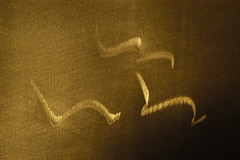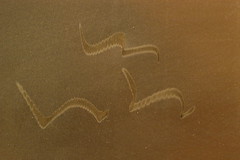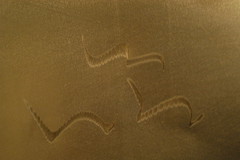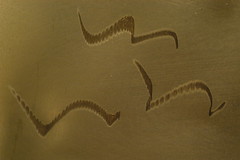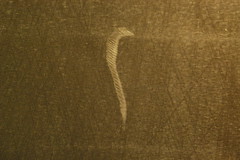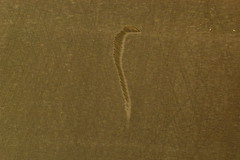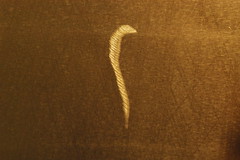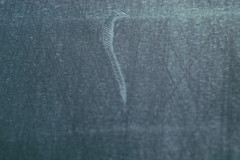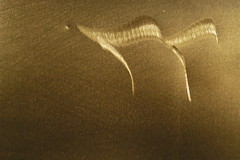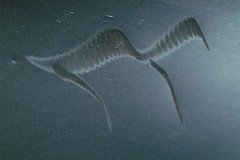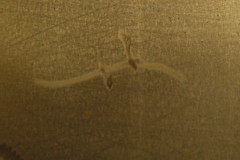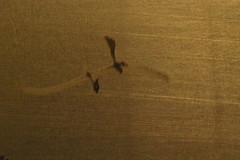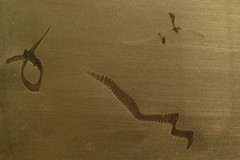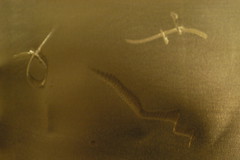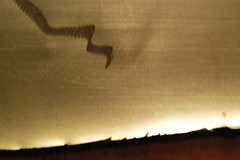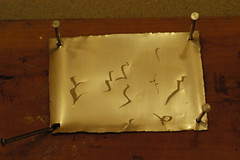|
All 5 books, Edward Tufte paperback $180
All 5 clothbound books, autographed by ET $280
Visual Display of Quantitative Information
Envisioning Information
Visual Explanations
Beautiful Evidence
Seeing With Fresh Eyes
catalog + shopping cart
|
Edward Tufte e-books Immediate download to any computer: Visual and Statistical Thinking $5
The Cognitive Style of Powerpoint $5
Seeing Around + Feynman Diagrams $5
Data Analysis for Politics and Policy $9
catalog + shopping cart
New ET Book
Seeing with Fresh Eyes:
catalog + shopping cart
Meaning, Space, Data, Truth |
Analyzing/Presenting Data/Information All 5 books + 4-hour ET online video course, keyed to the 5 books. |
Here are the first of a series of images ground into steel. I did experiments with making gestural images in stainless steel, but they are hard to photograph since they generate a multiplicity of views depending upon the angle of the lights relative to the viewer and the image (examples to come). Below two images (the fish, the horizon scene) barely ground into the surface mill-scum of regular steel. Steel is harder than stainless and so the grinding is just on surface and therefore lacks the holographic quality of grinding into stainless steel.
 |
| (click to see larger) |
 |
| (click to see larger) |
-- Edward Tufte
Stainless steel engravings, multiple views
Below, drawings cut into stainless steel. The drawings are shown in various lights; the first 3 images below show the same drawing under 3 different lightings. After that, each drawing is shown under 2 different lights.
-- Edward Tufte
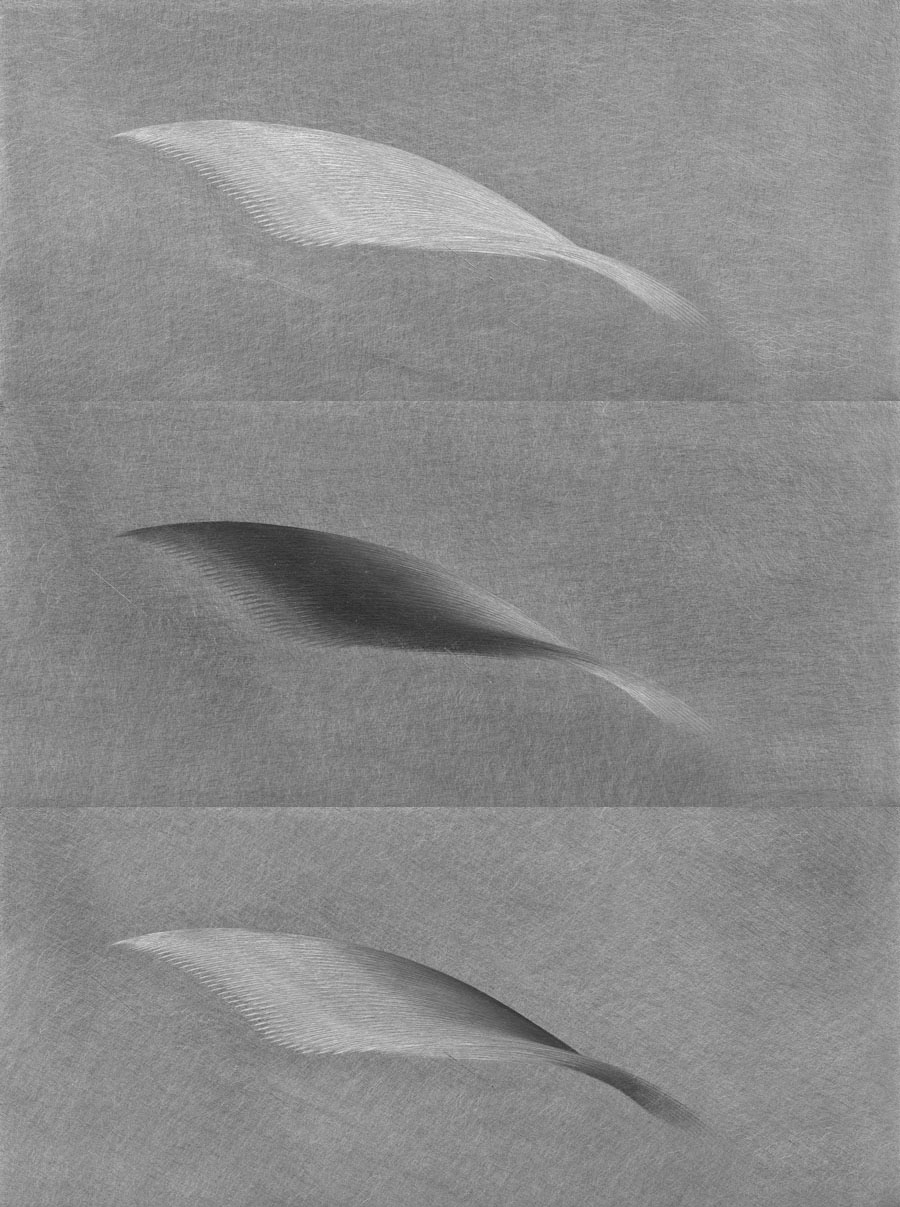 |
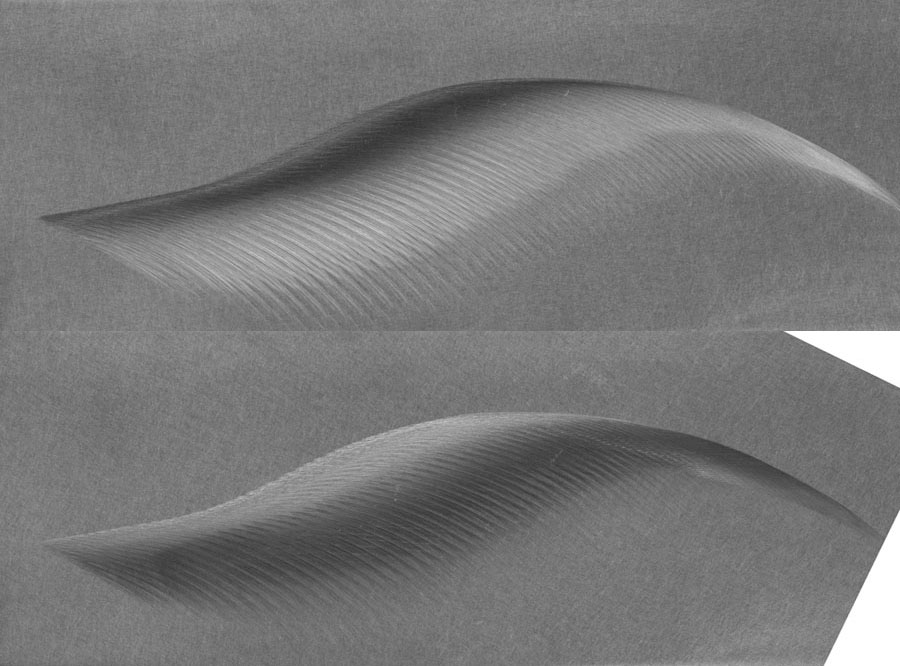 |
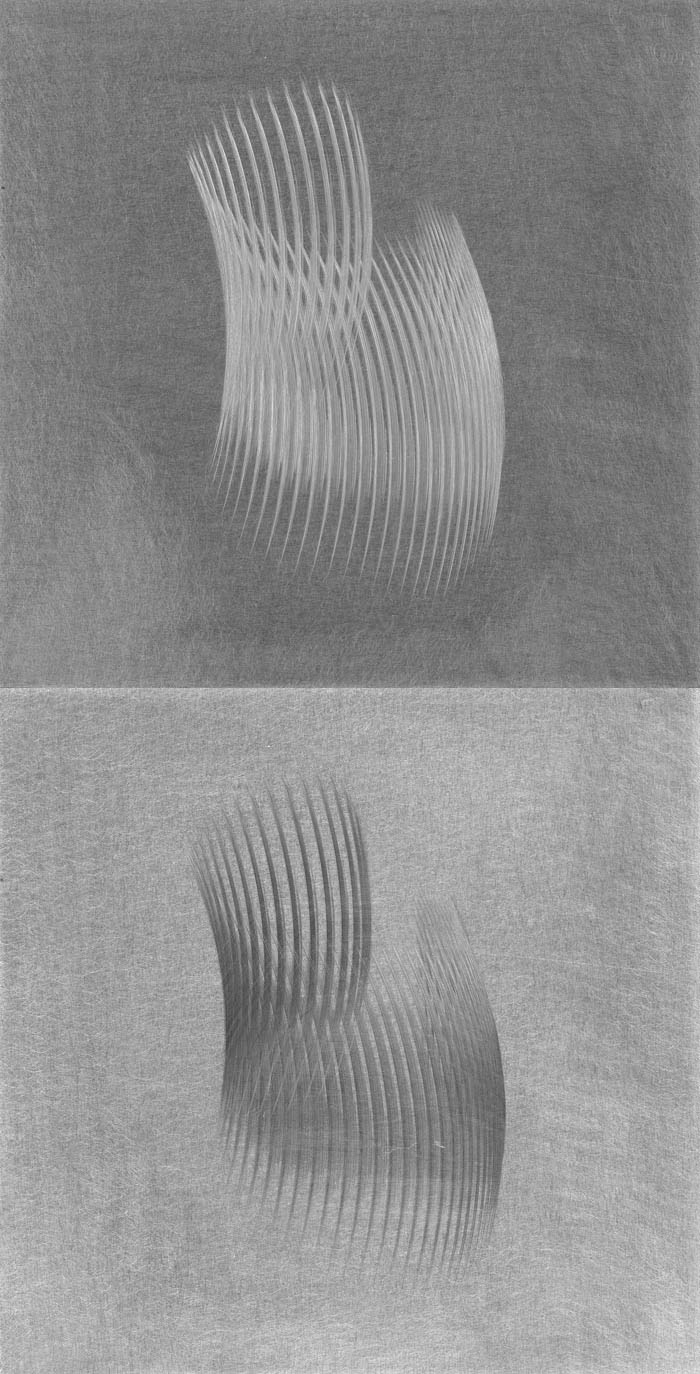 |
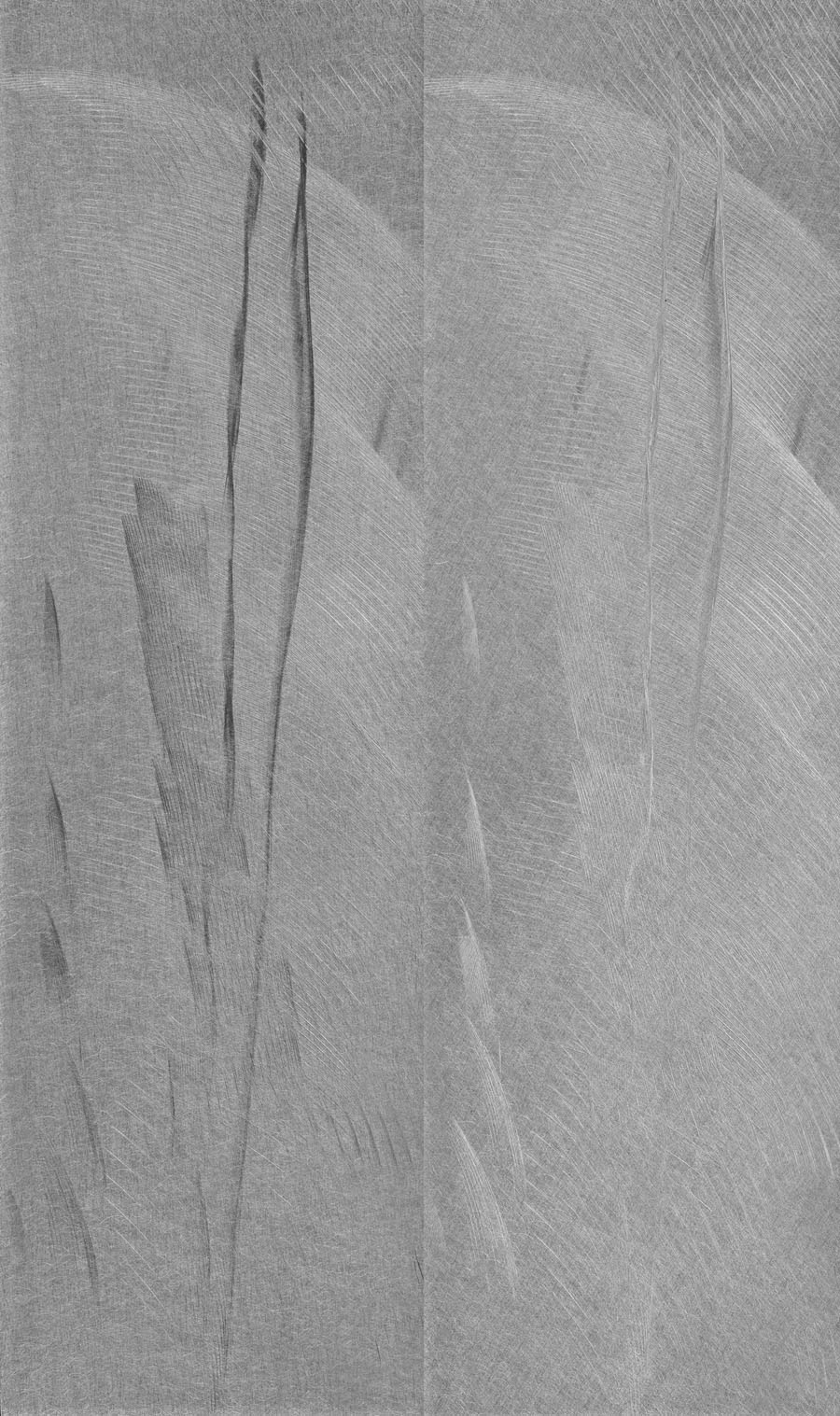 |
-- Edward Tufte
Images drawn on steel
Lovely! The elegance and detail of a carefully mastered pencil drawing, and the vividness of a 3D model. Still as dead as a fossil; an element of a picture that don't have the same color when I look at it from different angels tend to be ghostlike and non living, which is reinforced by the steels small spectra. I'm very curious about how the photographs looked before they were made black & white(?).
-- Peter H (email)
Response to images drawn on steel
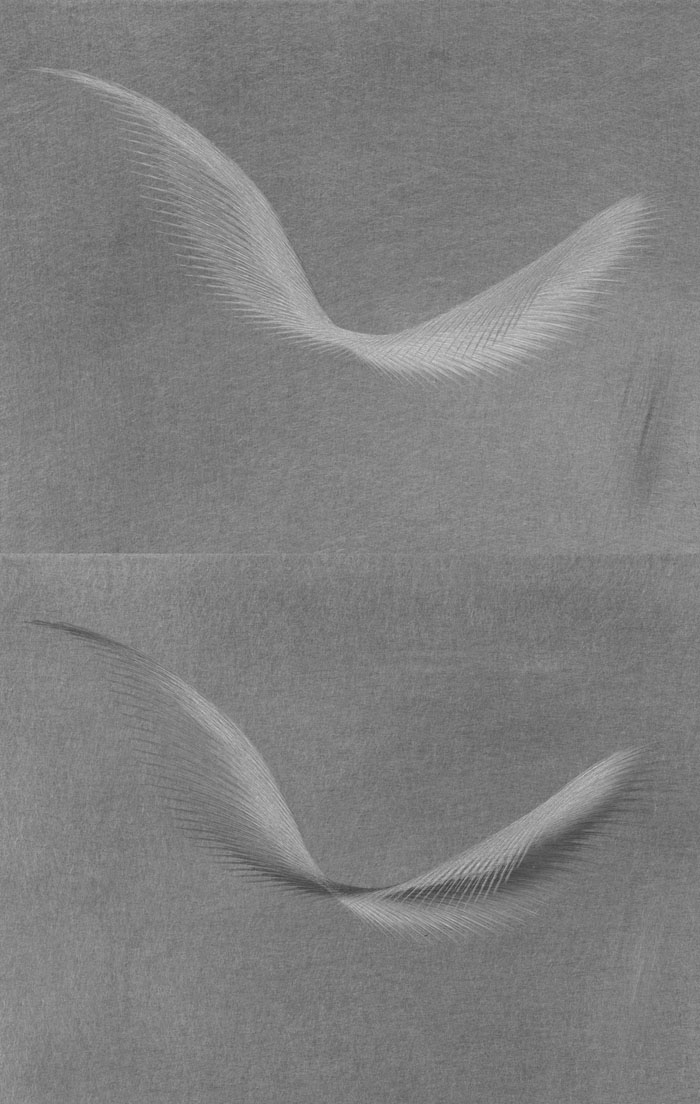 |
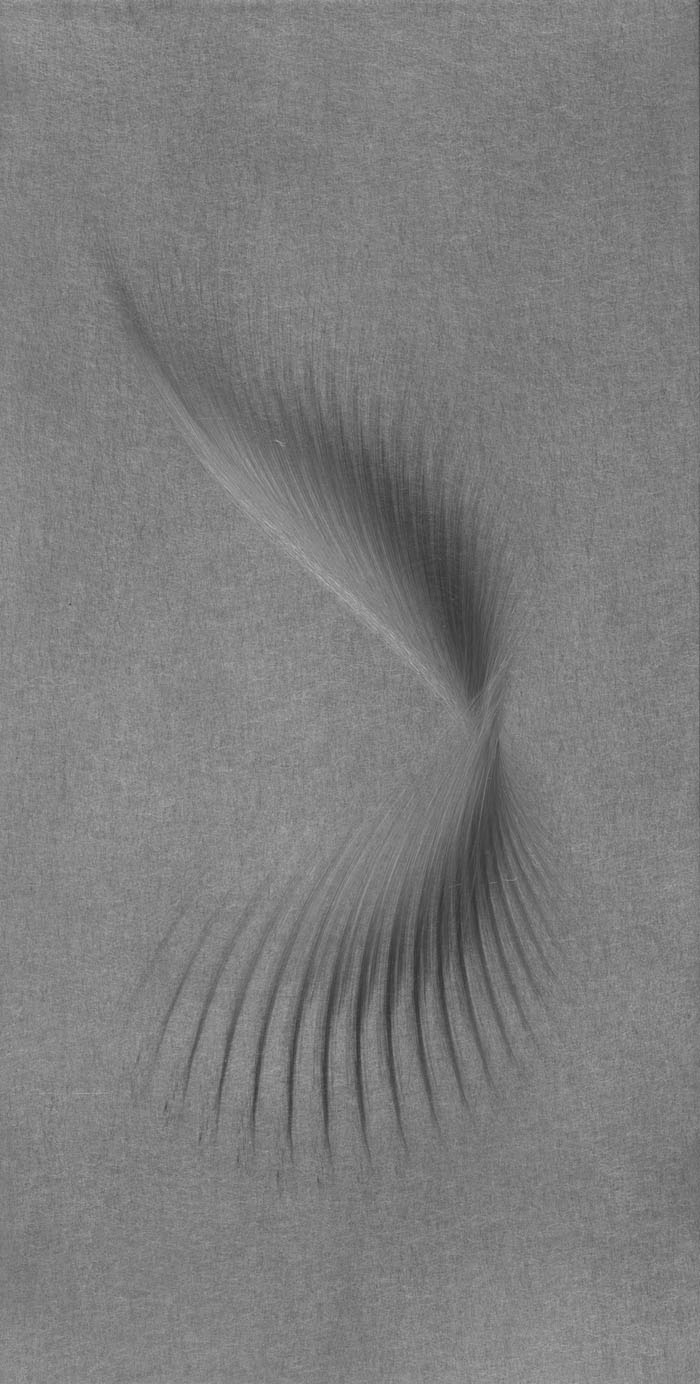 |
-- Edward Tufte
Steel as a canvas
It is nice work. Blanchard ground steel does make an interesting canvas. Few people realize the inherent beauty in raw materials of industry.
I have seen work by an artist freehand drawing scenes, portraits and landscapes, using a dremel tool on galvanized steel. This book http://www.amazon.ca/Colouring-Bronzing-Patination-Metals-Richard/dp/customer-reviews/0500015015> has encyclopaedic photographs of metal corrosion, quite beautiful.
-- Donald Bray (email)
hyperbolic paraboloid
What a beautiful hyperbolic paraboloid.
I am amazed at how the stainless steel version is so much more
expressive than the computer graphics that we have seen over
the years.
As a kid I used to love the effect of drawing straight lines
to get a curve... I probably still would if I had more time.
These are not my drawings:

SOURCE
http://www.mmwindowtoart.com/drawing/para1a.html"
http://www.mmwindowtoart.com/drawing/para2.html
-- Tchad (email)
Images drawn on steel
Very Interesting! I love the ambiguity. I see the forms in many contexts including biology, architecture and mathematics. What is the scale?
-- A. Clarkson (email)
Most of the images here are 50% to 80% of the actual size of the metal plate. There are also some much larger pieces, not published here. The stainless steel plate is 1/8" thick; the steel in the top 2 images is 1/4" thick. A variety of grinders are used to make the marks cut into the stainless steel.
The working metaphors are gestural, calligraphic, rhythmic, and, for the long thin vertical piece, late Cezanne landscapes. The resulting pieces, to my eyes, evoke quietly ambiguous and shifting visual metaphors of contours, semi-transparent sea creatures, flying dreams, feathers, and mathematical topological models. However I generally see and evaluate the pieces mainly in abstract terms of shifting light/line/curves/intersections/negative space, not in terms of visual/verbal metaphors of representation. This implies that the piece may survive visually regardless of which side is chosen as the horizontal baseline. Sometimes the baseline is chosen to head off a corny and accidental metaphorical reading. The size of the framed negative space surrounding the cut steel, and the relation of the negative space to the cut steel, are very important in making a piece work.
These are part of a series of table pieces or indoor pieces, an activity perhaps induced by the cold weather, which makes it difficult to work on the usual large outdoor pieces. These new pieces here are studies of surface texture, a variable that I have usually sought to calm down-- to reduce the expressiveness of the texture--in the large landscape works.
All the images above are made by simply scanning the metal piece at various angles. The scanning is done in gray scale to avoid any arbitrary or accidental color casts, which can result from the over-sensitive insensitivity of color scanning and printing. Multiple views for each piece are shown to demonstrate some of the holographic-like multiplicity of images produced by various angles of reflected light from the same piece. The final artwork can be seen either as prints (shown here, as the metal piece becomes an image generator), or as the metal piece itself. The actual metal pieces are much richer than any collection of scans or photographs.
Someday full-color in situ photographs will probably be published here.
-- Edward Tufte
Anisotropic reflections
Lovely, it is great to see this pictures!
Have you ever tried to draw on bended metal or used an "damaged" glass-Cutter to add 2nd level nanostructures, similar to the ones found in bird feathers?
The effects of "Anisotropic Reflections" due to nanostructures are amazing. See here for some other (less artistic) examples. The picture 28+35 show the effects especially well.
Regards
-- O. Chatelain (email)
Anisotropic reflections!
My private name was "David Smith style."
Thanks so much to Kindly Contributor O. Chatelain for identifying the phenomenon, which is most intriguing because it is what makes the multiplicity of views.
It means not isotropic and is pronounced an-isotropic.
From http://simscience.org/cracks/glossary/isotropic.html, we have these definitions:
isotropic: Properties of a material are identical in all directions
anisotropic: Properties of a material depend on the direction; for example, wood. In a piece of wood, you can see lines going in one direction; this direction is referred to as "with the grain". The wood is stronger with the grain than "against the grain". Strength is a property of the wood and this property depends on the direction; thus it is anisotropic.
-- Edward Tufte
Dear E.T.,
See here for a good mathematical introduction about this effects.
Maybe you can add more effects ...
- ... using multiple (moving) light sources (white/colored LEDs or similar).
- ... scratching glass from two sides, eventually adding a reflective layer on the backside.
- ... adding a multiple, very thin layer of transparent epoxy resin, scratching in a different direction. This may even lead to skin (lips) like effects.
More samples of this effects:
- "The pope's revenge" (a cross) on the TV tower of east Berlin.
- Light on water.
- Any reflecting hairs you see (Rastas will not work ;-).
-- O. Chatelain (email)
Scratching aluminum
These appealing new works trigger a memory of recent works by artist Andreas Nottebohm. His scratchings on aluminum produce a rich 3-D illusion from the surface, striking in their presence, but less remarkable on a computer screen:
http://www.mesart.com/users/andreas/artworks.jsp?artist=1182
Some highly-wrought art criticism that includes some some description of process (2/3 the way down):
http://www.mesart.com/users/andreas/reviews.jsp?artist=1182&press=24
Regards, Dennis
-- Dennis Webb (email)
Here are more recent engravings in stainless steel. The gestural calligraphic effects are produced by changes in line weight as if the brush thins, disrupts, and concentrates ink. These two images, taken in our kitchen about a minute apart during the butter light of sunset, differ greatly, in part because of the three-dimensional reflections from the cuttings into the stainless steel. The second image shows some appropriately atmospheric shadows cast by bamboo onto the engraved plate.
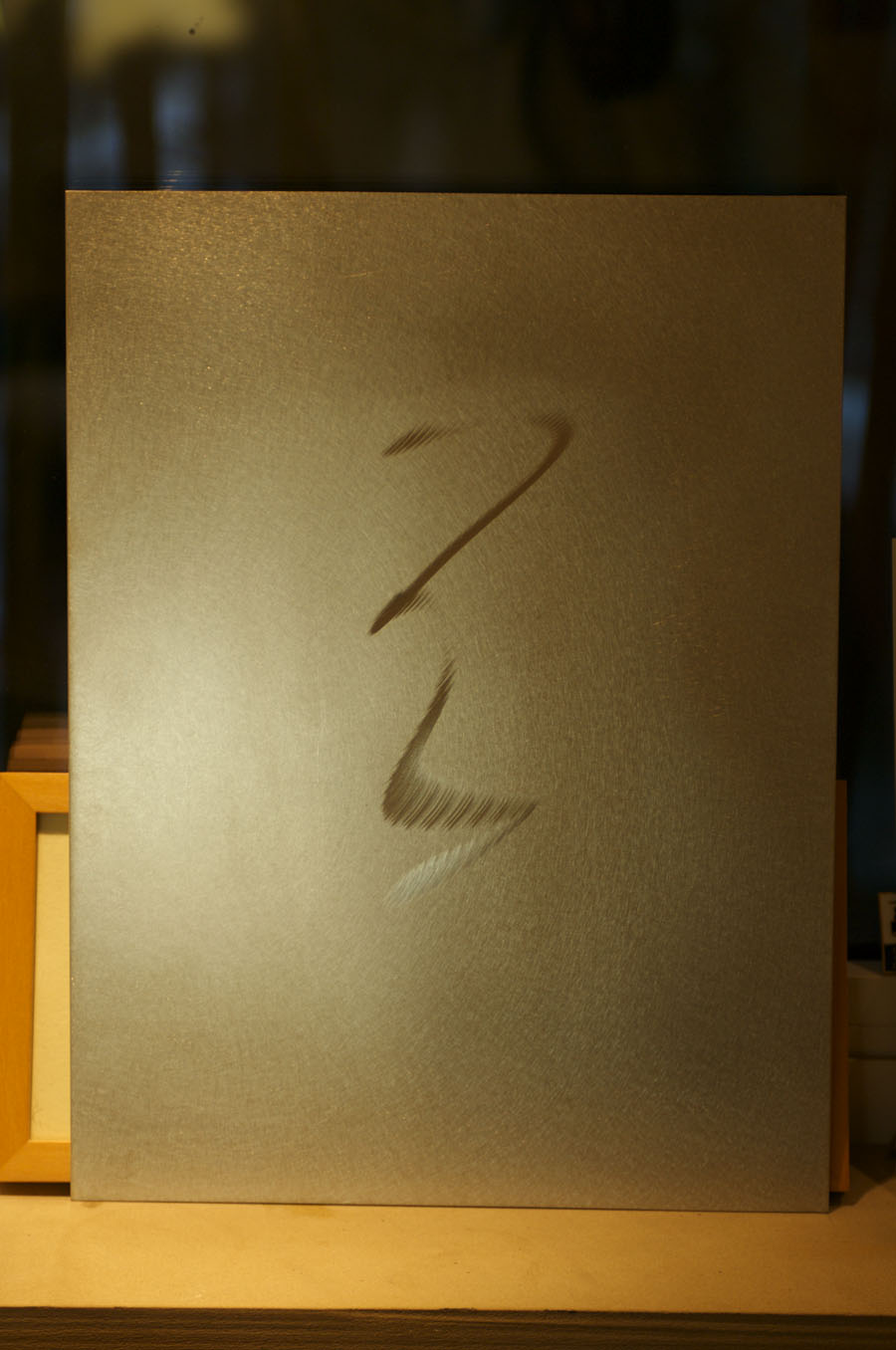 |
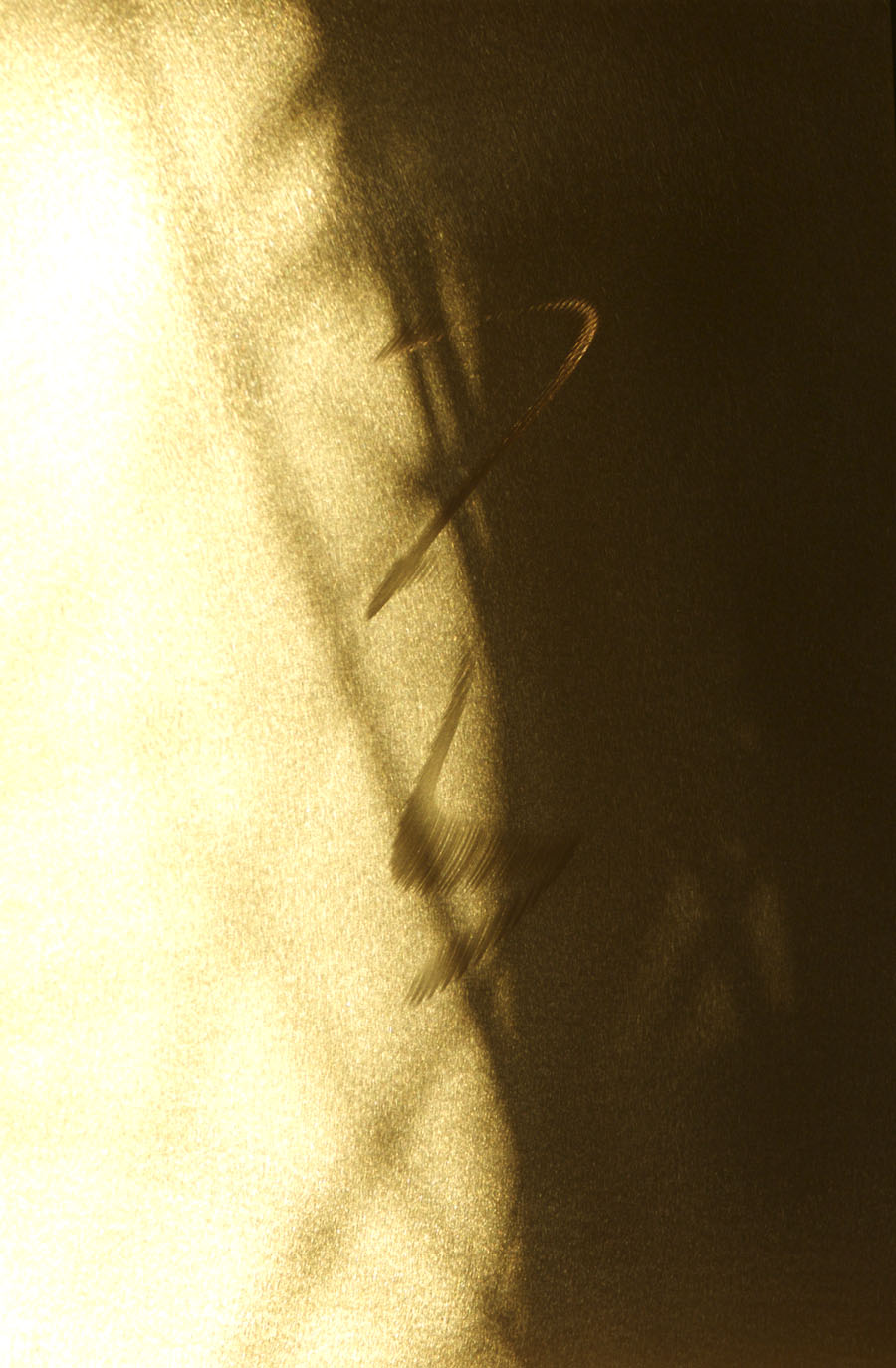 |
-- Edward Tufte
In these adjacent images: same piece, slightly different camera angle. These still-land comparisons don't capture the effects seen by an active viewer, who sees dynamic smoothly changing images as the light flows across the piece.
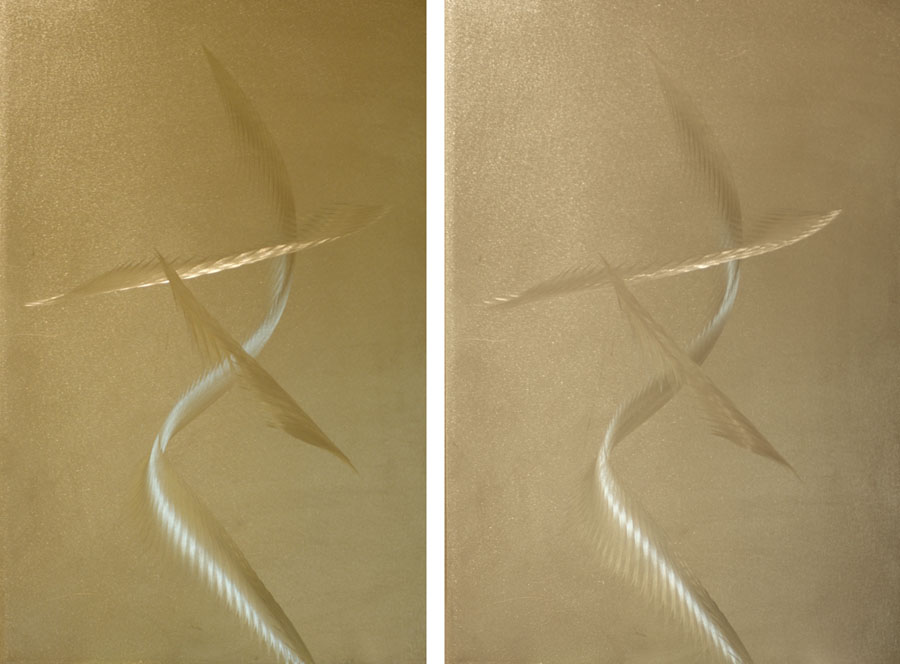 |
-- Edward Tufte
Here is an engraved plate, 30 by 12 inches, or 760 by 300 mm, photographed in a pill-up of new and old artwork. Again note the change in the image according to point-of-view, which in fact is about the angle of the light on the piece in relation to the camera. These images appear small to my eye because the actual piece is quite large, when indoors at least.
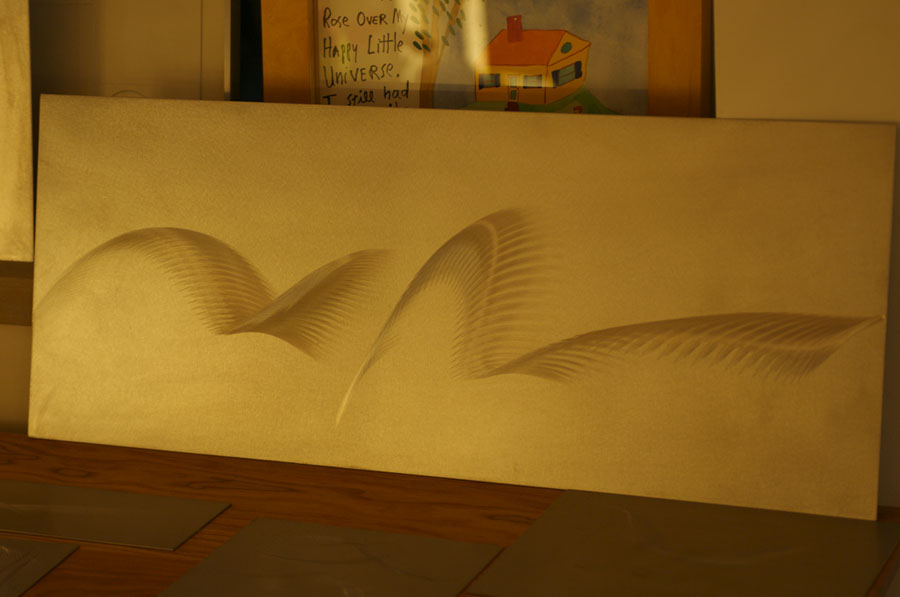 |
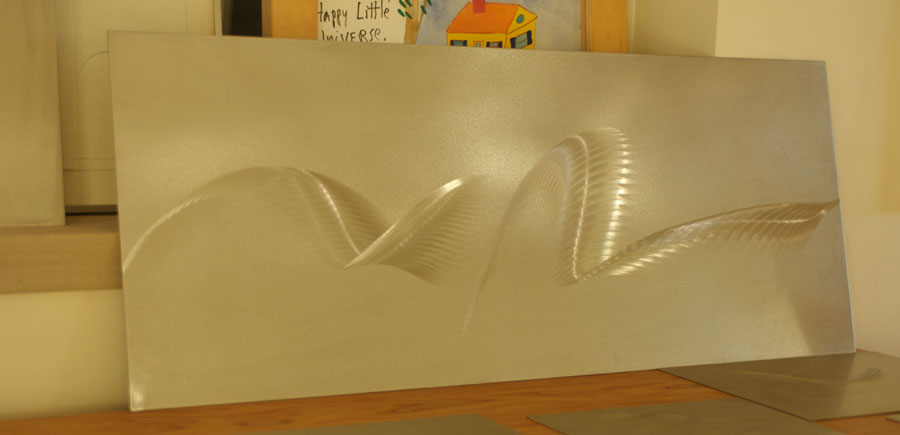 |
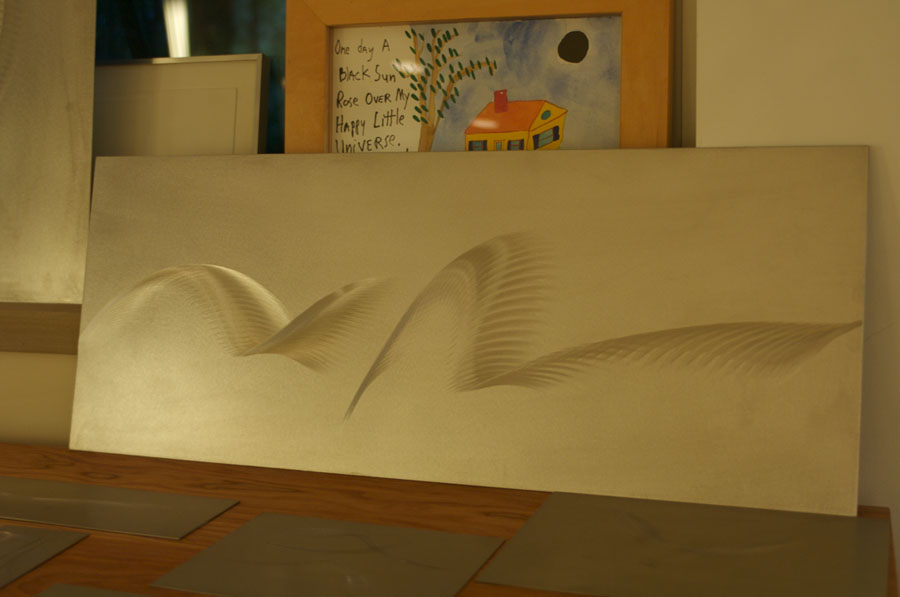 |
-- Edward Tufte
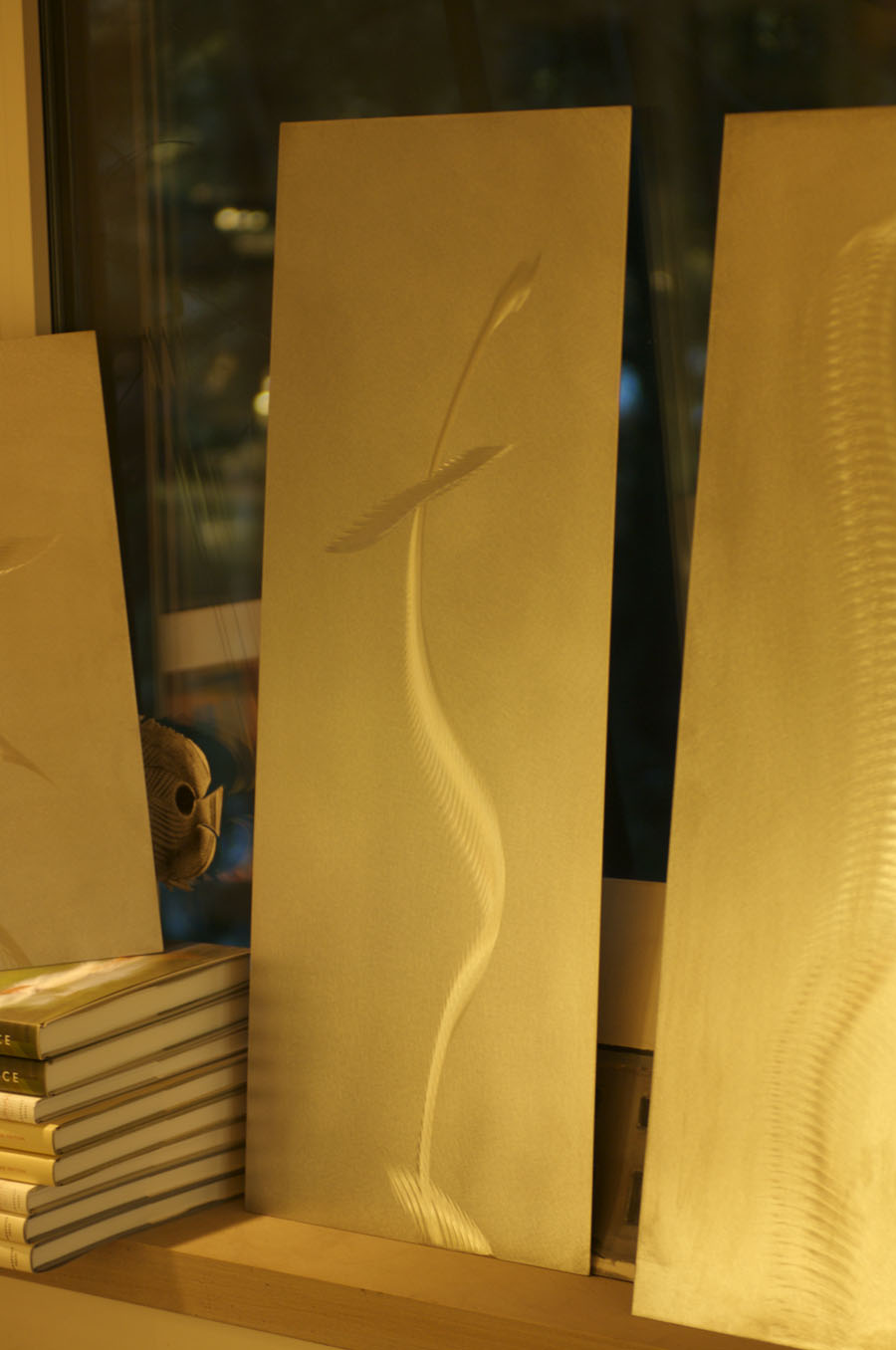 |
-- Edward Tufte
The recent images above are overly warm because the white balance on the camera was unintentionally set to sunlight, which then warmed up and exaggerated the halogen light on the pieces. The stainless steel is not really so golden, even in butter light and in halogen light. I prefer the cooler gray of stainless steel and so maybe I'll correct the color sometime.
-- Edward Tufte
More recent work. The first piece has soapstone markings placed on the engraved stainless steel.
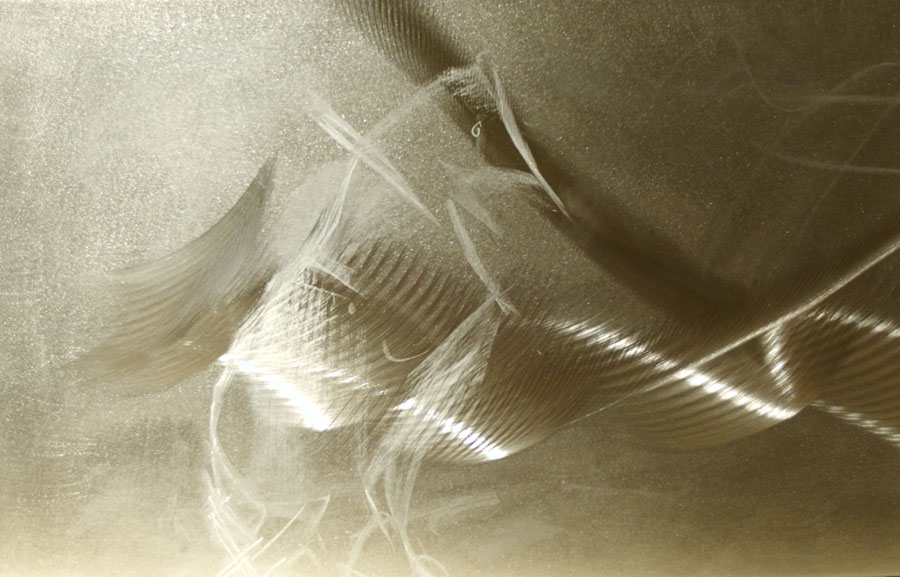 |
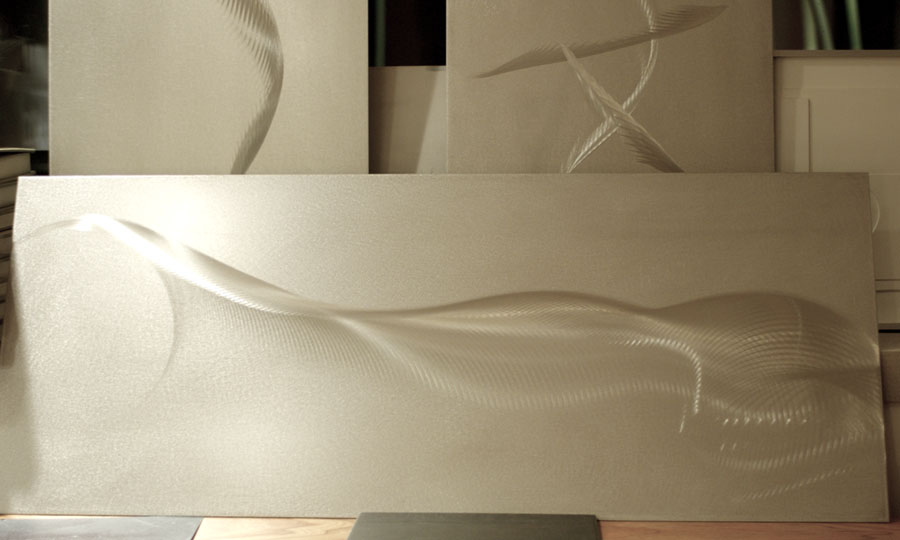 |
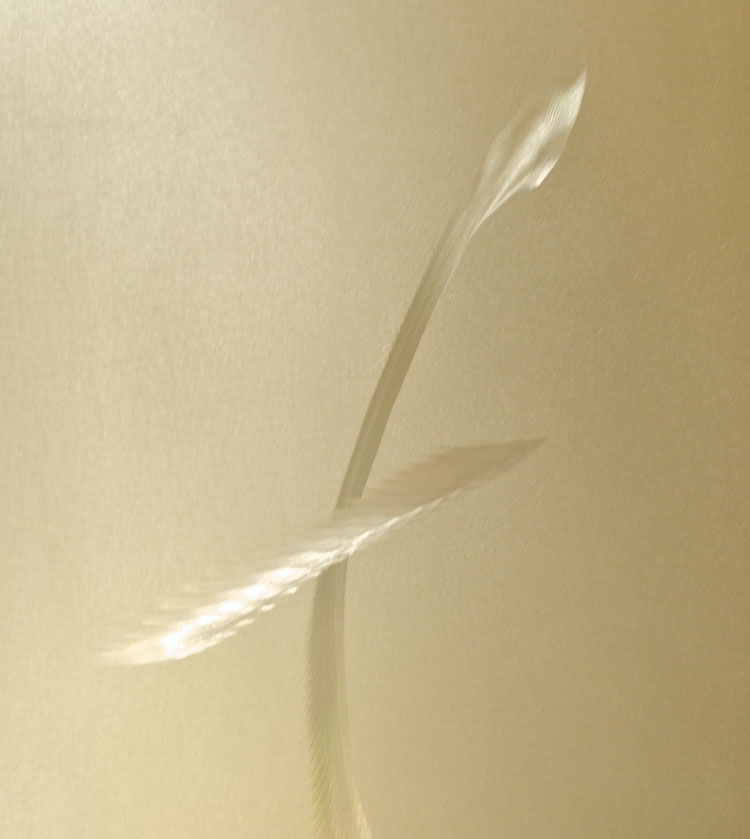 |
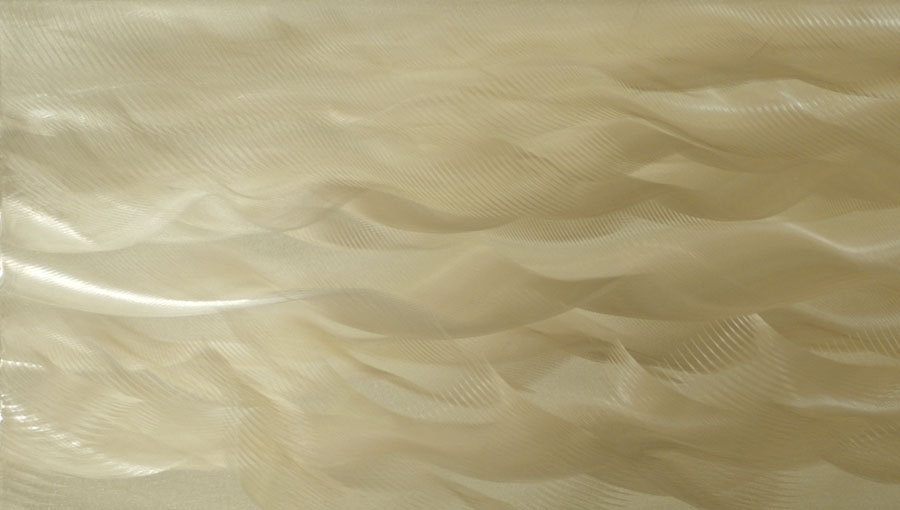 |
-- Edward Tufte
Below, some grinding on a new Bouquet piece.
The hints of Art Deco in the surface go with the Art Deco steel edges.
This style of metal grinding (using a single-action grinder) results in a surface that is very
active in sunlight, and is similar to the the stainless surfaces of George Rickey and
David Smith. In our grinding, however, the edge of the grinder cuts only briefly into
the stainless steel on each pass, thereby avoiding long graffiti-like lines in the metal
that flare up in sunlight.
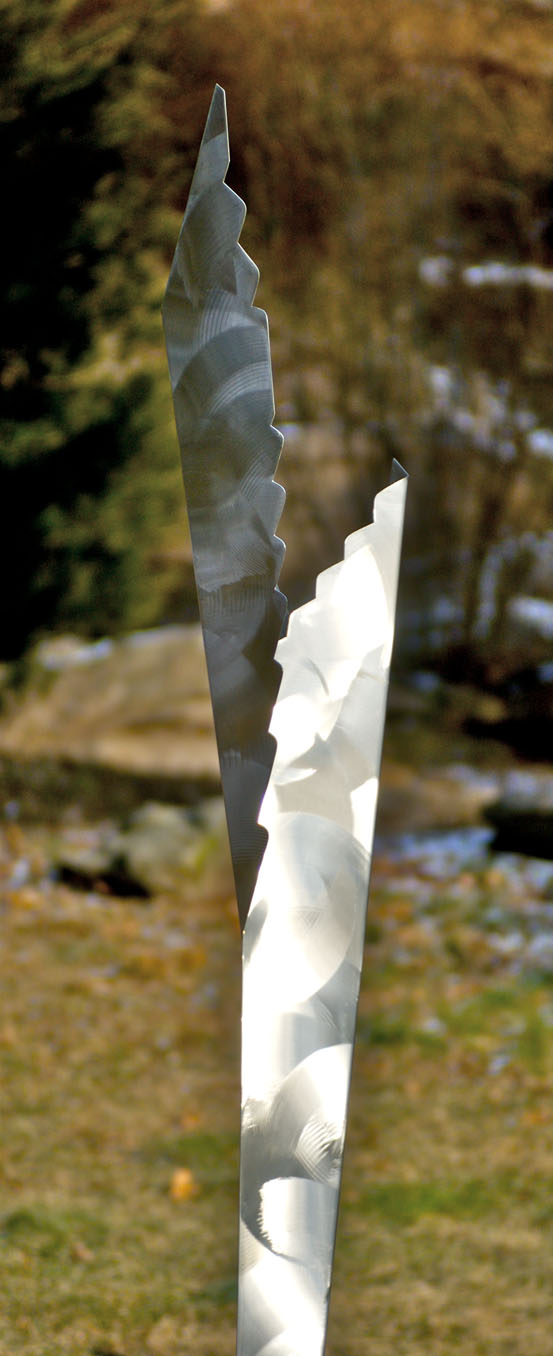 |
-- Edward Tufte
Scratches in bronze
Looking at your latest posting, I was reminded of the enormous brass propeller that stands at the entrance of the Mariner's Museum in Newport News, VA.
Every few years, they polish the brass and the swirls from the machining of the propeller are quite fetching. Here is a photo link:
Mariners Museum Entrance Propeller
Art
-- Art LaMan (email)
ET at work
Here's an early experiment trying out grinders and grinding gestures on stainless steel.
Note, under certain angles of reflected light, the dreaded grafitti effects, not all that
different from the desired 3D effects. The experiments aim to find techniques that
produce controlled and beautiful calligraphic effects on the stainless steel.
Instead of my usual breathing mask, which draws air directly in front of the face, I'm wearing
a new mask, which draws air to then be filtered distant from the area producing the metal dust.
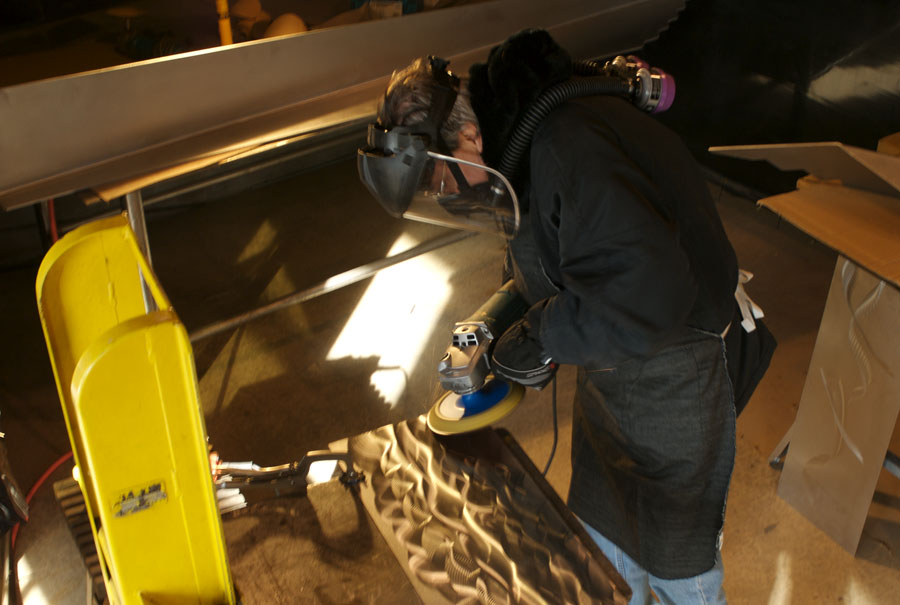 |
-- Edward Tufte
Anisotropic calligraphy
Here are 2 new engraved pieces, shown under varying light and color adjustments.
These 2 are part of a series on 12 by 30 in, or 30 by 76 cm stainless steel plate.
We have a lot of plates this size, which are probably leftovers from the Millstone nuclear power
plant (where our scrap dealer collects scrap metal). It is a good size for hand-grinding
images.
I think the first piece, immediately below, is one of the best in the series (of about 20 so far)
because of its complexity and proportions.
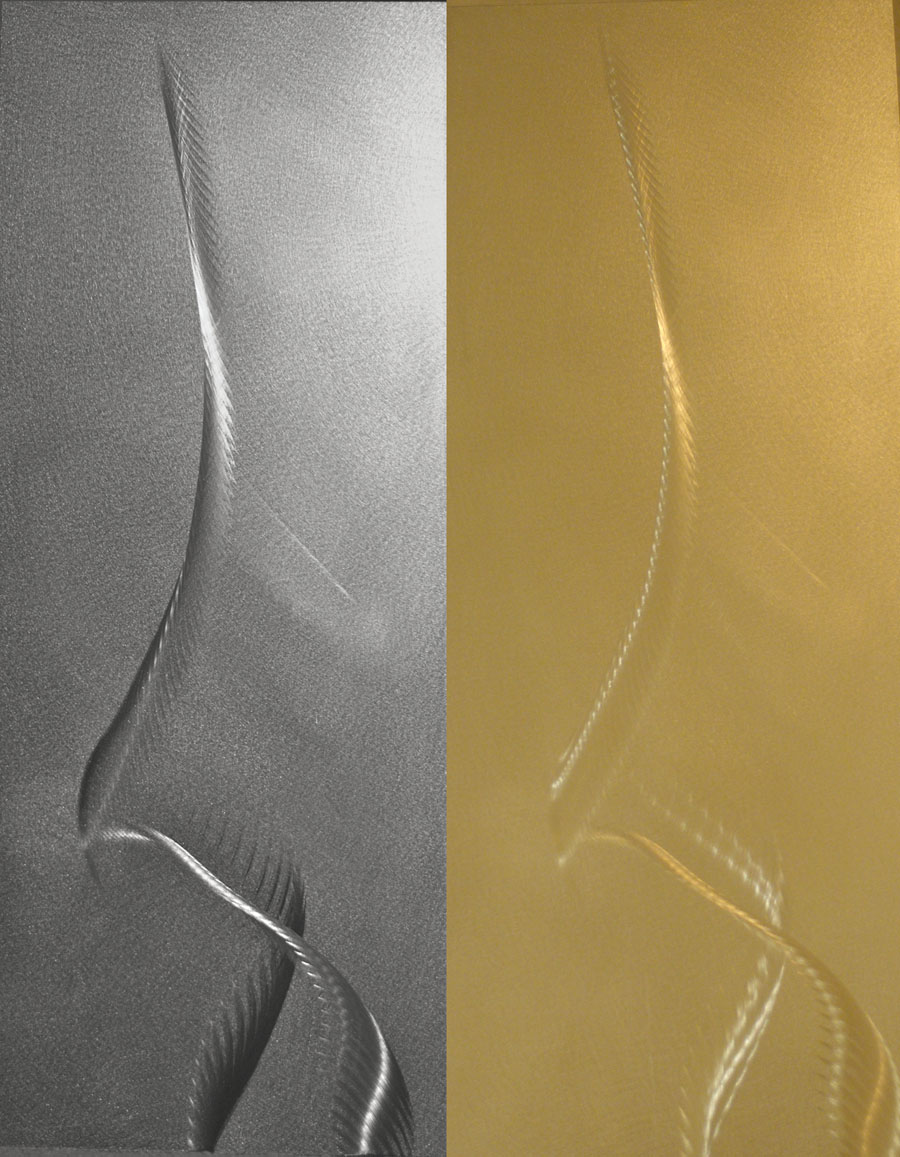 |
Here is a detail from the piece above. The anisotropic reflections are particularly beautiful,
with a rhythmic precision from the cuts into the stainless steel. I like pieces that
change, survive, and thrive under different scales, which are obtained by the observer's
change in distance in real-land, or by zooming in and out of photographic flatland.
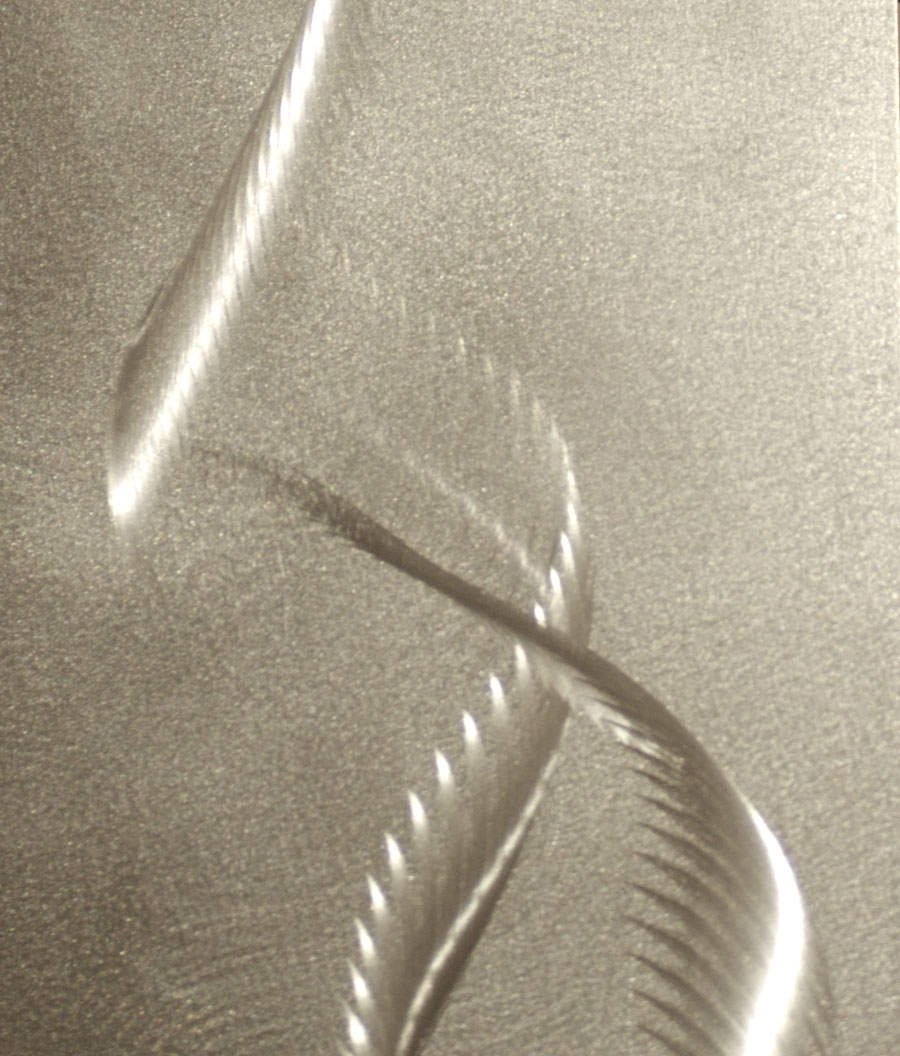 |
Here is another recent engraving, shown in 2 different adjacent images. This piece is likely
to become part of a diptych with the piece above, or a triptych with something else yet
to be made. In sorting over a group of engravings, I almost talked myself into a quartet
but then discarded the 2 weaker plates, leaving the 2 plates shown above and below
as the survivors.
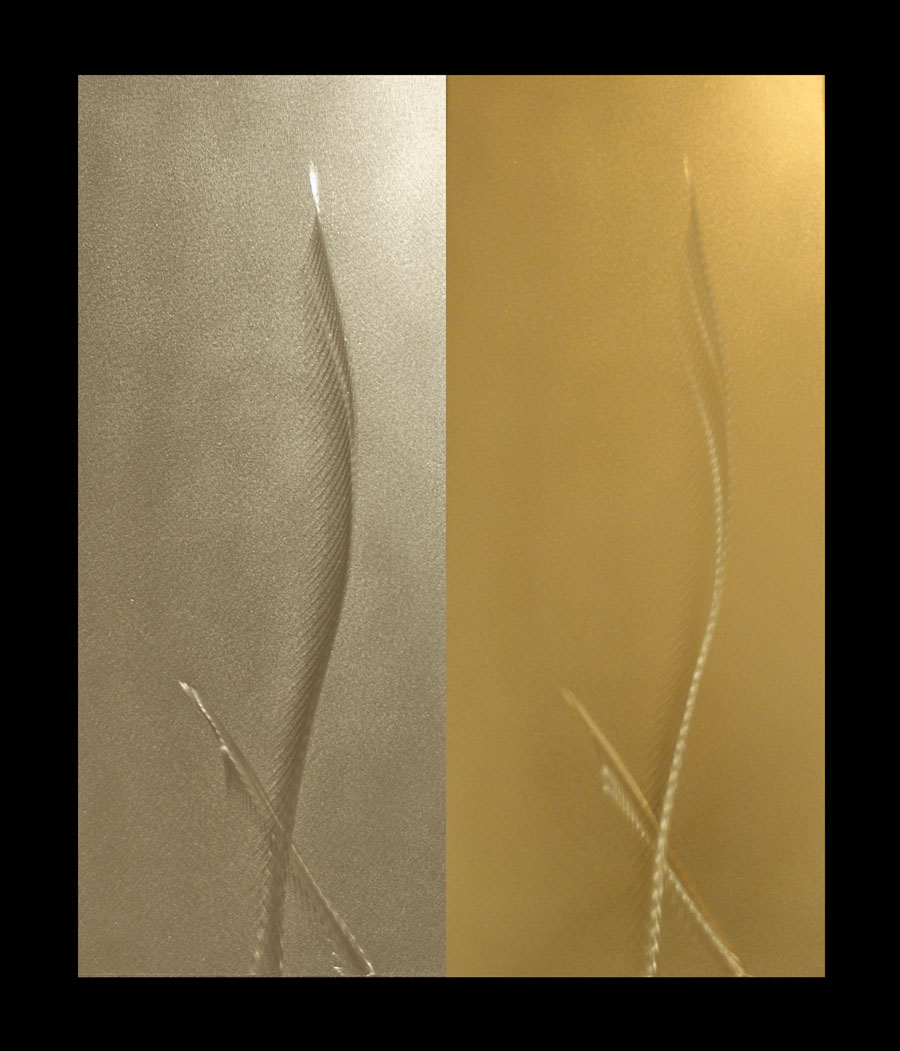 |
-- Edward Tufte
Steel engravings
People interested in (irregular) images drawn on steel may also be interested in "Engine Turning", which are highly regular images drawn on steel (and other metals). See http://www.cs.ucr.edu/~eamonn/et/et.htm
-- Eamonn Keogh (email)
Eamonn Keogh, our Kindly Contributor, opens up a world of precise and beautiful engraving of systematic patterns onto metal in the link above. Imagine using this technology for cutting a subtle Ben Nicholson relief into metal. In addition to amazing metal work, Eamonn Keogh is also a computer science professor at UC Riverside!
Along with several colleagues, he has constructed rich visualizations of DNA and time-series. See "Visualizing the Similarity of Human and Chimp DNA." The time-series work, with sparkline-like overtones, is here.
What steel engravings, engine turning, high-resolution multivariate time-series analysis, and sparklines have in common is an intensity of resolution--and trying to understand the visual information produced by intense resolution.
-- Edward Tufte
Sculpture and Anisotropy
What you said about the grinder calligraphy you have been doing lately reminded me of a page that describes how it is possible to make holographic images by hand by scratching a reflective surface. I see that you have described your work as "holographic," so perhaps you have seen it already. Notice that the author claims that the images are truly, not metaphorically, holograms.
-- Daniel Lipsitt (email)
Below, a new piece, a stainless steel engraving (30 by 12 in, or 760 by 300 mm) with 3 calligraphic figures.
Shown are 3 photographs taken from slightly different angles to the plate, which becomes an image generator.
The wondeerful color variations are generated by the interactions among the piece, the angle of the camera relative to the piece,
and the ambient light (mostly soft sunlight + some halogen work lights) in the kitchen. Falling on the engraved plate,
the borrowed light generates--or paints--a multiplicity of complex and subtle color shifts that would be difficult to create otherwise.
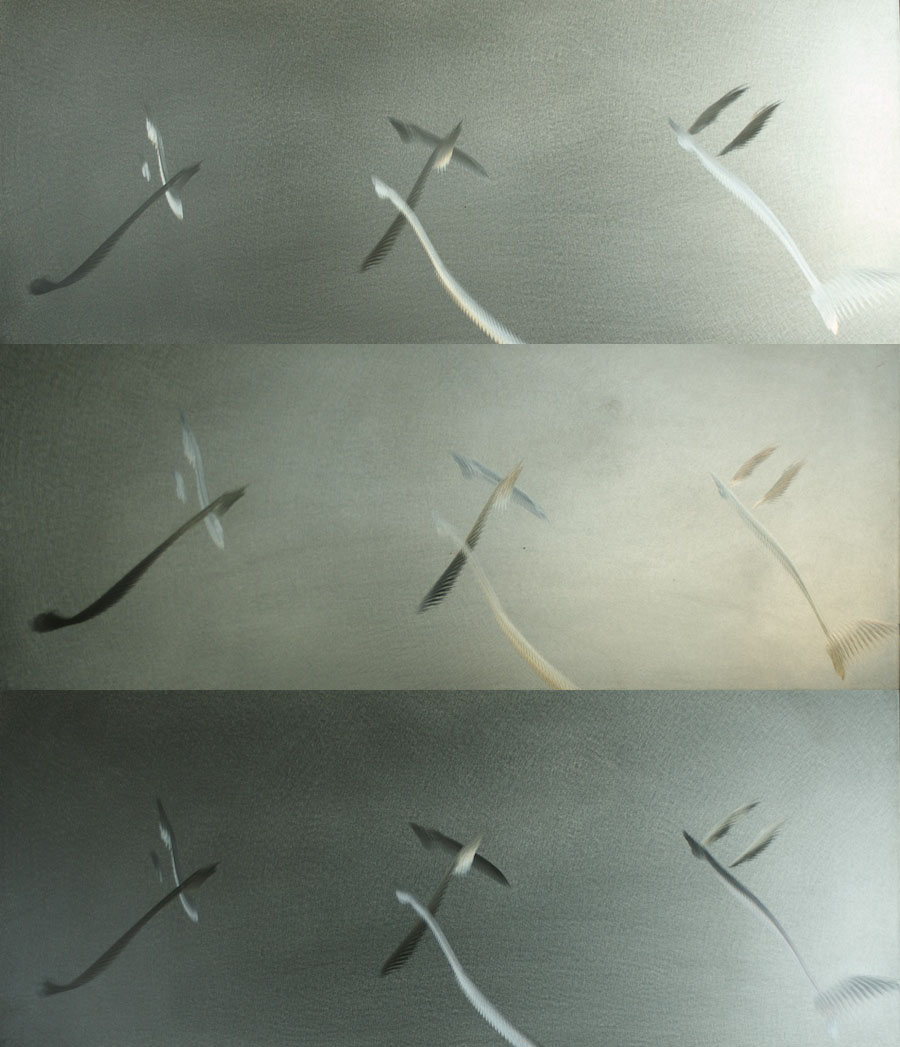 |
-- Edward Tufte
Bobcat scratches in the snow
Some bobcat (lynx rufus) scratches were found in the ice-snow at Hogpen Hill Farms. The bobcat urinated on the twig, and then did the usual back-paw scratching-cleaning-cover-up gestures.
The result was this set of ice-snow anisotropic (see above) engravings.
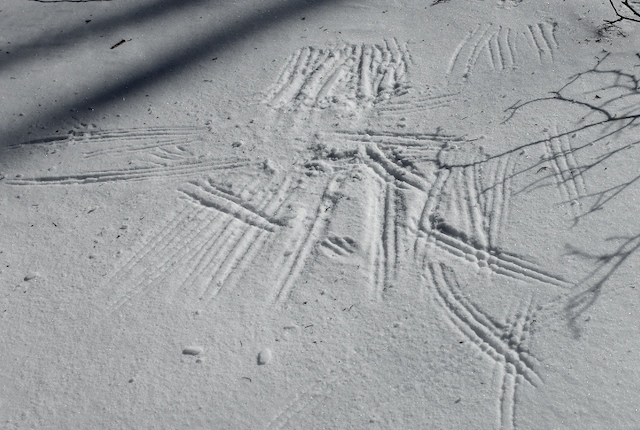 |
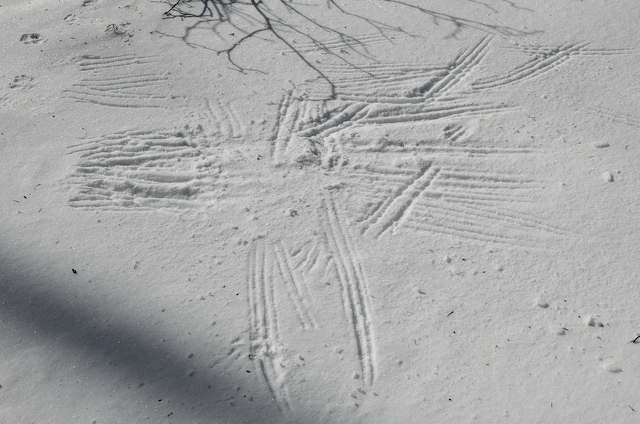 |
-- Edward Tufte
Anisotropic calligraphy
Several new engravings on stainless steel are shown below.
The color-casts result from ambient light interpreted by the SLR-camera settings
and then gently adjusted globally in Aperture.
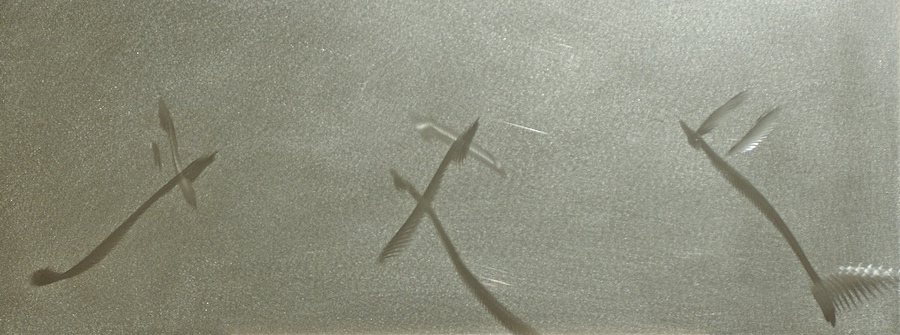 |
 |
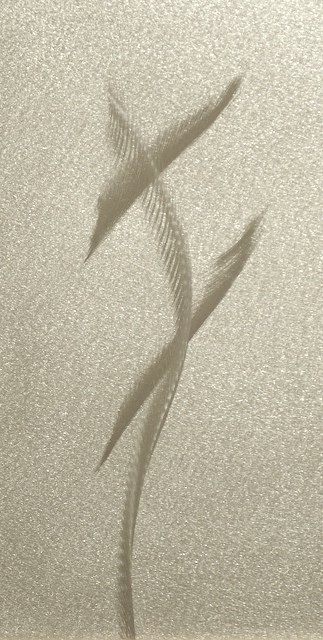 |
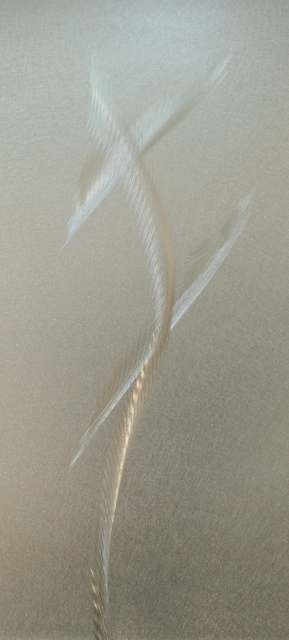 |
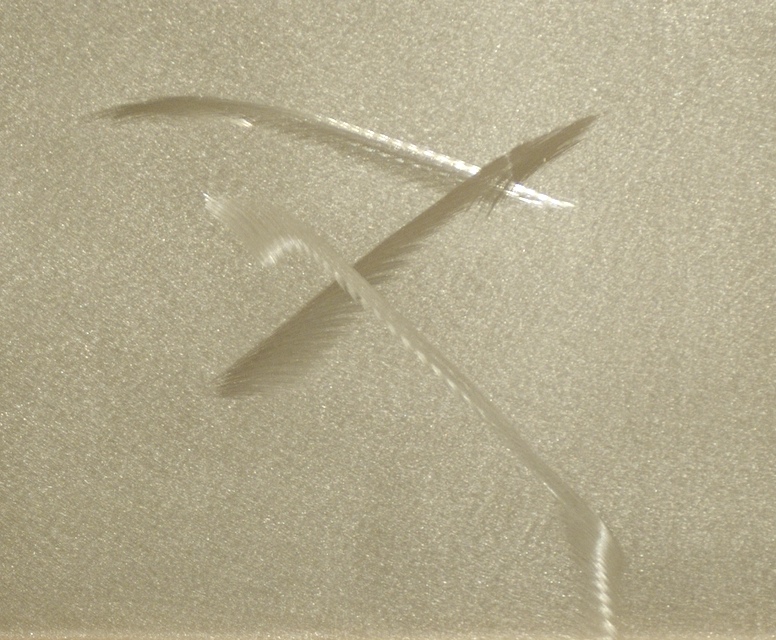 |
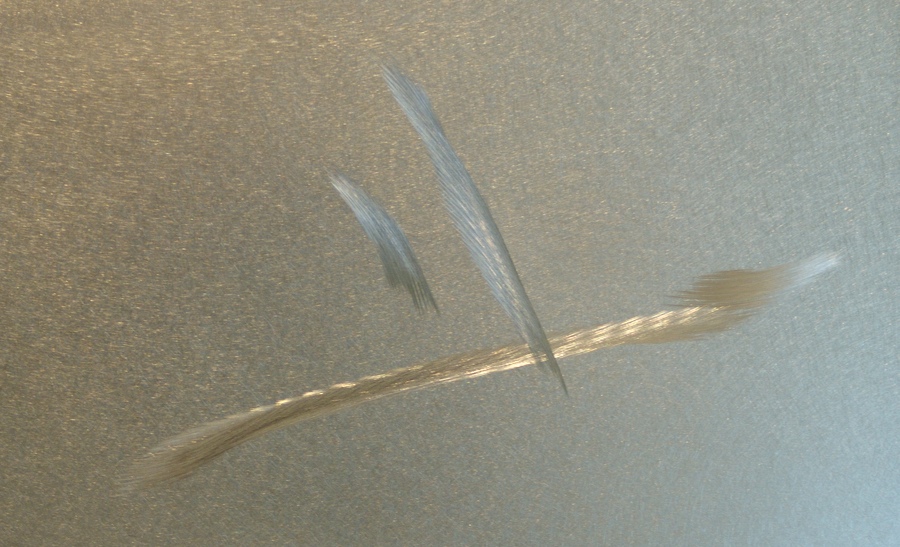 |
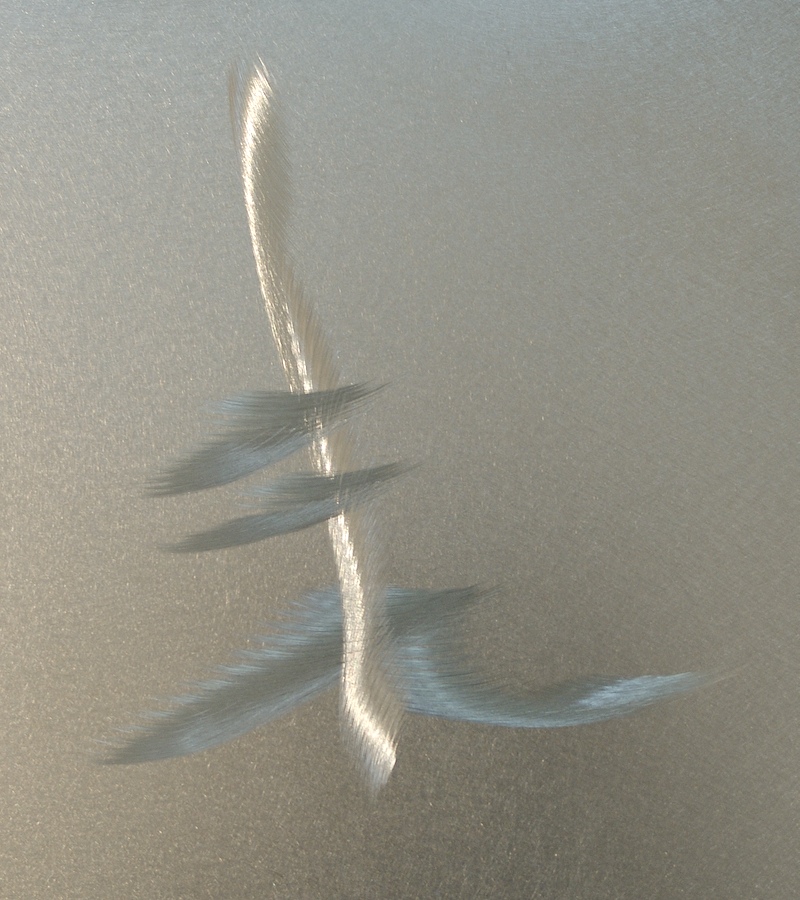 |
-- Edward Tufte
Japanese Calligraphy and Stainless Steel
Are there any lessons to be learned from the art
of Japanese Calligraphy?
In many ways drawing on steel seems similar: well
balanced images are more pleasing ( to my eye anyway )
than those with radically different stroke weights,
there appears to be a certain rhythm and grace inherent
in the finished product, and let us not forget that
the images can only be drawn once - touchups are not
possible... one can only embellish the flaw.
I have tried this with a stick and sand and it is
quite engaging but extremely frustrating for the
perfectionist.
ET has mentioned the elegance and information density
of kanji symbols in the past. Like the kanji, do the
images drawn on steel conjure up information that is not
expressly contained in them?
Are there additional
ways of harnessing this?
Enhancing Fluid Movement
Are there ways of facilitating fluid movement by using
other grinding tools or attachments that may be better
suited to the task than an angle grinder?
Dremel Tool with a flexible shaft
http://www.dremel.com/DremelCMS/Pop-ups/ProductImagesPopup.aspx?I=66226&tab=3#
Flexible Shaft Grinder
http://www.suhner-abrasive-expert.com/site/index.cfm?id_art=15727&vsprache=EN
-- Tchad (email)
Try out a Dremel
A disc grinder, with its size, the percessive force of its rotating motor, and directionality of rotation, imposes fairly severe constraints on the worker. A bamboo ink brush also imposes relatively severe constraints: the tool is unexpectedly light, the hand is relatively far from the point where tool meets surface, and the brush must be moved in certain directions relative to its angle with the paper. In contrast, a dremel flex shaft is a bit like the fine-tipped felt marker of grinding tools. Unless I'm doing fine polishing work on small surfaces, I leave mine in the toolbox. With both the grinder and the ink brush, the artist must plan a movement, predicting as best he can the consequences, but ultimately the outcome of tool on surface is predicted before the first visual feedback is available, that is, there is a lag in the motor-visual-motor feedback loop. Improvement comes with experience in the material, which improves the accuracy of the artist's predictions, and editorial decisions after a body of elements have been created.
-- Niels Olson (email)
Response to Images drawn on steel
My Dremel tool has also remained in my toolbox since the day it was purchased. That said, I can't help but wonder if the larger version of the same concept would be useful?
-- Tchad (email)
Wheat in the sun / fur
Some more "bionic & causal" samples:
* Wheat in the sun
* Fur & Hair
* Bobbins
Just enjoy them ... .
-- O. Chatelain (email)
Glass
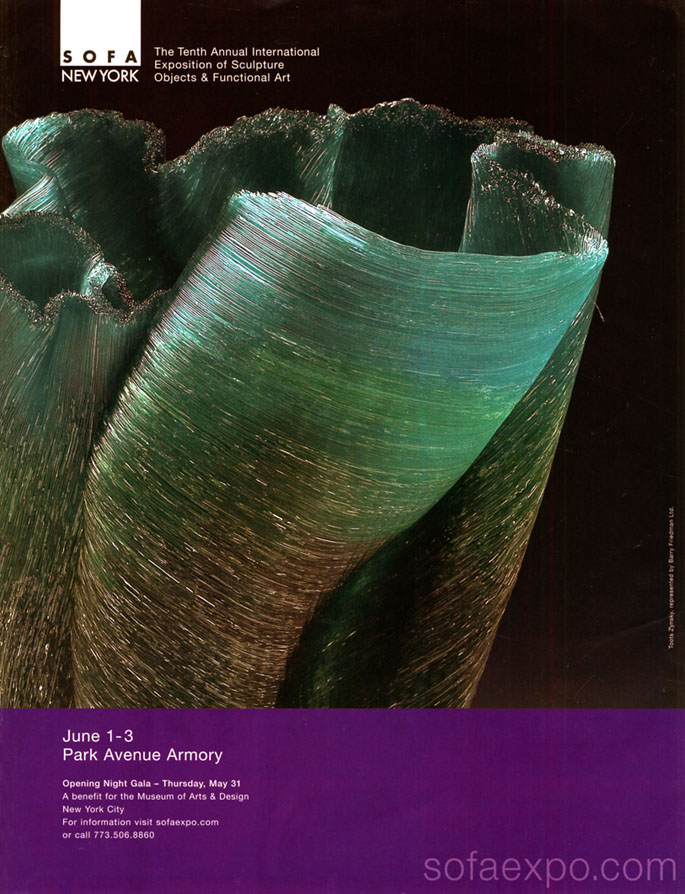 |
Source: Toots Zynsky, represented by Barry Friedman Ltd.
-- Edward Tufte
Lovely -- and you're closer to holography than you might realize. If one carefully controls the position and curve of each of a large field of micro-mirrors, one can make a full-fledged hologram. Lots of examples at this site. Here's one with a moving camera:

and here's one almost a meter square:
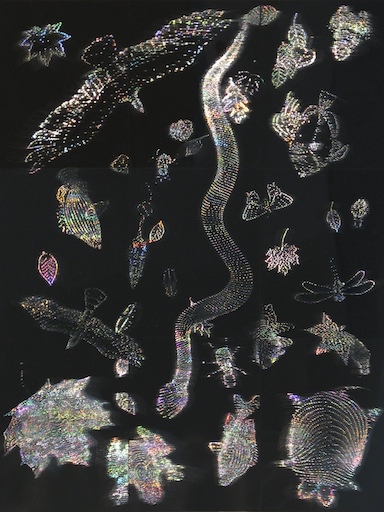
regards, MB
-- Matt Brand (email)
Use of scrap from nuclear facility
Hi,
Just thought I would suggest that it may be wise to test metal (or any material) scrapped from a nuclear facility for residual radioactivity. Once I obtained a radiation sensing device I was amazed by how many common articles radiate in interesting ways.
On board a jetliner background exposure is much higher, and much early art glass work used various radioactive elements for vivid colors. Mineral specimens from exotic locales are often quite radioactive as well; in these cases breathing particulate debris is most dangerous compared to mere exposure to alpha radiation.
JR
-- J. R. Hodel (email)
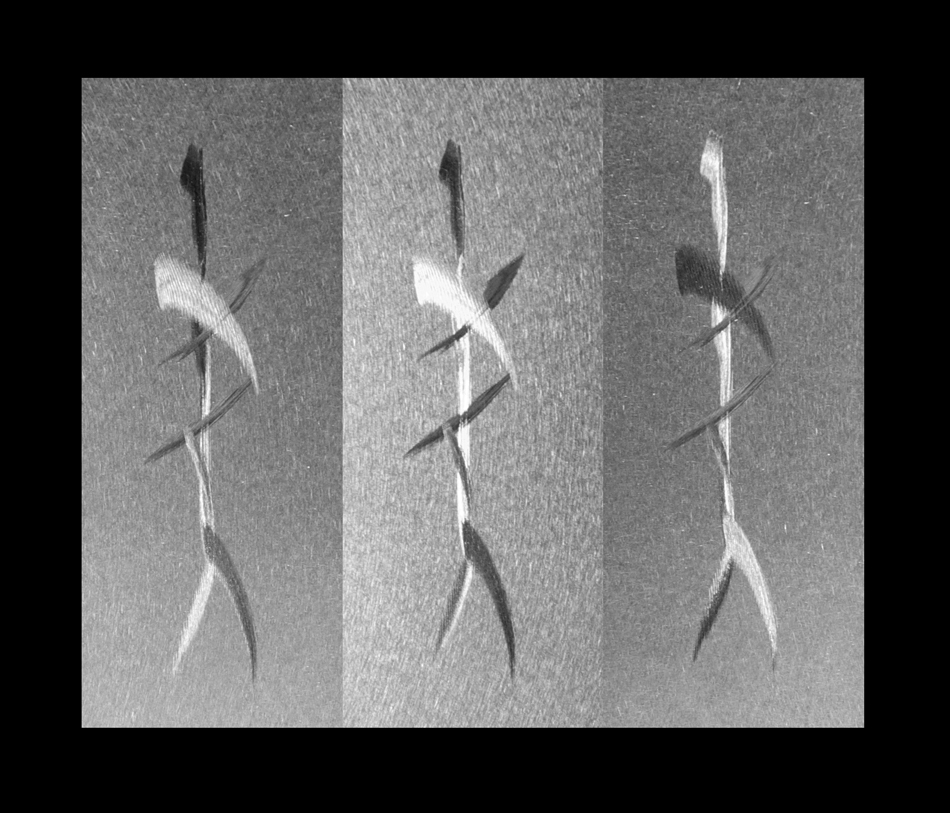 |
-- Edward Tufte
|
||||||||||||||||||||||||||||||||||||||||||||||||||||||||||||||||||||||||||||||||||||||||||


